Suffer the Children / Sara Jayne Townsend
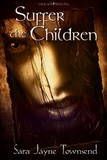 Lyrical Press / April 2010
Lyrical Press / April 2010
Reviewed by: Rick R. Reed
Synopsis: (From Lyrical Press)
Fear has a face…
Orphaned at eighteen, Leanne's life is adrift in a sea of grief and drug use. She washes up on the shore of estranged relatives, the Carver family, struggling with loss of their own. The transition from her South London council estate to her new home in the Surrey middle-class suburbs is difficult for Leanne.
But beneath the respectable veneer of the quiet neighborhood, something terrifying lurks. Displaced and troubled teenagers are disappearing. Leanne recruits her cousin Simon and his girlfriend Carrie to help get to the bottom of the sinister mystery. Can the three of them stop a creature of unimaginable evil before Leanne becomes a target?
Review:
Suffer the Children is a good, old-fashioned horror story, with a touch of the paranormal, a little classic mythology, and a healthy dose of suspense, all set down in a contemporary British setting. It’s the kind of book perfect for curling up with on a rainy afternoon and reading from cover to cover. Author Townsend has a facile, easy way with her prose and a keen observer’s eye for people, resulting in unique and breathing characterization. Townsend’s characters are mostly young adults, late teens to early twenties, and she captures them well, in all their late-adolescent angst and bad decision-making.
It is this age group that forms the central conflict and central horror to the novel. The orphaned main character, Leanne, has lost her mother to a drug overdose (one long in coming) and discovered, almost at the same time, that she has an aunt and a ready-made family she never knew existed until her mother died. Leanne’s entry into this middle-class, white bread family, after growing up in what is essentially a London ghetto, makes for the novel’s initial dramatic tension.
But then teenagers begin disappearing. Teenagers like Leanne, fosters, delinquents, and the like, all turn up missing and leave not a trace behind. The Carver family, who have adopted Leanne, lost their own daughter, Emma, and she may have fallen victim to the same plight as the other missing kids, although her disappearance does not fit the pattern. But the author cleverly explains Emma’s disappearance.
The tension really ramps up in the novel when the pattern of disappearances begins to get noticed, not so much by the authorities, but by Leanne and her friends.
Unfortunately, the tension is slow in coming. And I fear many readers may not stick with Suffer the Children long enough to get to the really good parts. A reader is a full quarter of the way into the book until he or she truly begins to see some horror and some nail-biting suspense. If I hadn’t been reading this book to review, I don’t know that I would have stuck it out to get to the latter part of the book, when the tension, dramatic conflict, and terror really accelerate. In short, I think Townsend could have benefitted from a good editor, to help her shape and focus the novel a bit more. A good horror novel needs to grab a reader right from the start and Suffer the Children fails on that count.
But it is worth sticking with. In spite of a rather predictable climax and denouement (I saw the villain coming from a mile away), the book works. The author’s creation of likable characters who grow over the course of the novel, the palpable sense of tension and dread, and the effortless prose all combine to make Suffer the Children a horror experience I can definitely recommend.
Purchase Suffer the Children by Sara Jayne Townsend.
Columnist Rick R. Reed is the author of more than sixteen novels, three collections, and short fiction in more than twenty anthologies. He lives in Seattle, WA. Find out more about the author at his official author website.
They That Dwell in Dark Places / Daniel McGachey
 Ghost House / November 2009
Ghost House / November 2009
Reviewed by: Blu Gilliand
Some horror comes in the form of a scream; some, in a whisper. In the right hands, either form can make an equal impact. Likewise, if the skill level isn't there, both approaches can fall flat. Daniel McGachey takes the quiet road in They That Dwell in Dark Places, and the result lands firmly in the middle — a collection of stories that pass the time ably enough, but then pass just as easily from memory.
McGachey's collection is dedicated to M.R. James, who, along with writers like T.E.D. Klein and Charles L. Grant, mastered the form of the quiet horror story. Theirs are stories that don't rely on buckets of blood, creative kills and liberal profanity to drive readers to the end; instead, they employ atmosphere thick with dread and tension, and evil that lurks deep within the shadows, to produce their scares. (By the way, don't read this as an indictment of those other kinds of stories — when skillfully used, buckets of blood, shocking kills and creative cussing can be just as effective and tons of fun.) There's an almost genteel feel to work of this type, a coziness that makes reading such stories more of a comfort than a thrill. The writers of quiet horror – the good ones – use that coziness against us, but of course that's what we want them to do. We are there, after all, to be scared.
McGachey’s love of this type of horror story is evident throughout They That Dwell, from the aforementioned dedication right on through to the style of his prose. Stories are related in a formal voice, as though a professor of literature has invited you into his parlor to share a few intriguing tales that he's picked up during his studies. The majority of the stories here employ just such a device, as a matter of fact — the ghost story is often not something that the reader is experiencing, but is instead a tale that one character is sharing with another. This works sometimes, but the effectiveness wears thin when story after story is presented this way. There's a lack of connection to the characters because the events often aren't happening to the people whose eyes we're seeing the story through, but instead have happened to someone else.
Take "The Ravelled Tress" for example, which was one of my favorite stories in the collection. It's an evocative tale of a lodge haunted by the malevolent spirit and murderous locks of a former inhabitant. You read that right — it's a story about killer hair. It's atmospheric, compact and quite effective, and yet, right in the middle of the story, one of the characters sits down to tell the backstory to the others — in front of a roaring fire, no less! By this point in the collection, it's become expected that someone is going to enter the story simply to tell another story, and here he is. Although "Tress" does focus more on the repercussions of the related events, bringing it that much-needed sense of immediacy that's missing from other entries, it's still an all-too familiar method of storytelling once you've reached this point in the book.
That criticism aside, there are good stories to be had here. "The Crimson Picture," about an artist with the (unwanted) ability to paint the horrific futures of his subjects is a solid piece of work. "The Traveller's Companion" centers on a salesman who buys a book of ghost stories by an admired author at an auction, only to find that many of the stories have been changed since their initial publication. As the reader becomes more and more obsessed with the stories in the book, he finds that fiction and reality are beginning to blur at the edges. On top of that, people connected with the book have begun to seek him out, as this special edition was made for a very particular audience, and owning it has consequences the man never expected.
Some might dismiss They That Dwell as horror lite, and perhaps McGachey does try too hard to capture the flavor of James. But there's potential there for more, and hopefully McGachey will work a little more of his own voice into the mix in future efforts. In the meantime, if you've exhausted your supply of quiet horror and have a taste for more, pick a couple of stories out of this collection. The book in its entirety may be too much of a similar thing, but a selection here and there will do the trick nicely.
Purchase They That Dwell In Dark Places by Daniel McGachey.
Living After Midnight: Hard and Heavy Stories / Edited by David T. Wilbanks and Craig Clarke
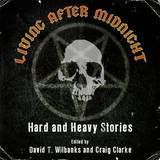 Acid Grave Press / November 2010
Acid Grave Press / November 2010
Reviewed by: Martel Sardina
“Which do you love more: Heavy metal music or horror fiction?” is a question this reviewer would have a hard time answering. Any longtime fan of both art forms knows that the two are, have been, and will continue to be wonderfully intertwined. A common theme found in many metal songs and many horror stories is that of chaos. From war (an external and obvious form of chaos) to love to alienation to the degradation into madness (the internal battle waged in the mind), many of the works in both forms are filled with imagery that plays on that theme.
The stories in Living After Midnight are filled with manifestations of chaos. In “Spooky Tooth” by Randy Chandler, the chaos is more of the internal kind. Dakota Joe Cadillac, a Hunter S. Thompson-esque rock journalist, gets more than he bargained for when he finally gets the opportunity to interview Caleb Dogberry, the “(were)wolf at Metal’s door.” Chandler captures the characters’ voices perfectly. Having read this piece several times now, it gets better each time. The words flow with a poetic grace that I hope to capture someday in writing of my own.
Next up is “Iron Maiden” by Matthew Fryer. Set near a pub on the Thames River, Fryer captures the eeriness of London as Dom stands outside, smoking a joint, his calming pre-gig ritual. Dom hears a voice calling his name. He’s stunned to see a ghost ship – appropriately, the Iron Maiden – materializing in the fog. Is he smart enough to resist the siren’s call?
Steven Shrewsbury’s “Black Sabbath” offers a different take on the chaos that ensues after a zombie apocalypse. In this world, zombies are not immune to the effects of rot and decay, leaving survivors to fear something far worse than the undead. Nothing conveys the pain and sorrow of this piece better than its closing line, “God will understand.”
“Judas Priest” by David T. Wilbanks invokes a little black magic to bring the chaos in his tale to life. What good is protection from earthly harm if its cost is torment in another plane of existence? Kent Gowran’s “Motorhead” is the story of a heist gone wrong. And finally, L.L. Soares brings the anthology to a close with “Slayer.” This story is probably the most extreme in terms of violence and sexual content. Abercrombie has pledged his life to Saint Rainer. Leon, lead singer of the 80s band Honey Load, is being pressured by his former bandmates to capitalize on the resurgence of metal music and get the band back together. When the two meet, whose interests will be served?
While filled with action, these three latter stories lacked the emotional connection their predecessors possessed. This reviewer felt less vested in what happened to the characters over time. In Soares’ piece, in particular, that lack of emotional connection was felt the most. When a character dies, the impact of that loss needs to be shown; otherwise, the violence and gore are just for show.
In the introduction, Wilbanks explains that the anthology was born after asking several author friends if they would be interested in writing a story with the name of their favorite metal band as the title and the chosen band’s musical vibe as the loose inspiration. For this reviewer, “Spooky Tooth” was the clear winner in that challenge. However, fans of metal music and horror fiction can expect to find something else to love in the virtual pages of this book, if they don’t agree.
Purchase Living After Midnight, edited by David T. Wilbanks and Craig Clarke.
"The Wheel" and "We" / Bentley Little
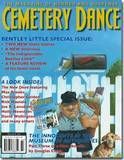 from Cemetery Dance / Issue 64
from Cemetery Dance / Issue 64
Reviewed by: Daniel R. Robichaud
Cemetery Dance's 64th issue is a Bentley Little Special, which includes reviews and appreciations for Little's work and features two new stories: "The Wheel" and "We."
"The Wheel" is a gruesome piece about innocence destroyed. The premise is straightforward enough: three young friends visit a widow for a chance to spin a game wheel mounted to her apartment wall. The choice prize on this cheap bit of construction is "Collect $100." Acts of racially motivated violence fill the remaining slots — things like "Kick the Kike" or "Choke the Chink." Should the needle land on one of these, the spinner must perform the deed. Avoiding this duty results in an undeclared punishment. The unnamed narrator soon discovers evil can be quite seductive. The opening line tells us: "I wanted to spin the wheel again." And so he does.
"We" begins on a highway outside Las Vegas. A routine speeding ticket acts as the doorway to oddity. Had the woman in the red Sentra not been attractive, Officer Ed might not have stopped her. When he steps up to her door, she begins apologizing immediately, taking responsibility as opposed to behaving belligerently. It's only after she's received her warning and driven away that Ed realizes she said "We" instead of "I" though she travelled alone. Ed soon discovers this woman was his first encounter with a mysterious phenomenon sweeping Vegas: People communicating with unseen Others. This is not simple hysteria, but a disquieting invasion.
Little's prose is both lucid and dreamlike, giving readers a view of the real world skewed. Here, Little's brand of surreal horror, where nearly absurd situations turn suddenly and convincingly horrific, reveals ugly truths underlying the everyday blasé.
With "The Wheel," Little delivers a horror story with no overt supernatural trappings but plenty of subtle supernatural implications. If taken at face value, the story offers the same kind of real world evil populating Jack Ketchum's works. In fact the use of a young, arguably innocent protagonist invokes both Ketchum's The Girl Next Door and "The Rifle." However, an air of mystery hangs over this story. Who made the wheel? Who enforces its unspoken rules? While the story supplies suppositions and dark conspiracies, it offers few reliable answers, making each spin a gruesome act of faith. It is no stretch to read an otherworldly menace behind this device.
In direct contrast, the supernatural presence in "We" makes itself quickly apparent. In short order, the story moves from the everyday into unsettling territory. The supernatural element spreads like a highly communicable disease (as contagious as The Stand's Captain Trips, say). While this sickness does not leave its victims dead, Ed does not want to be its next victim. Little's knack for ramping up suspense makes the story intense and engaging. Though the plot culminates in a not terribly surprising ending, the story delivers its goods through Ed's compelling emotional journey.
If a gripe can be made with "We," it's one of scope. The cast of characters and the situation are all a little too large for the number of words given. This material could easily expand to fill a novella or complete novel. Little drops plenty of names and relationships, but Ed is the story's only real character and though his story is complete, "We" leaves plenty of questions unanswered. It reads like a fragment from a larger work. Though "The Wheel" is also somewhat ambiguous, this reviewer found its conclusion more satisfying.
Gripes for "More, please" aside, "We" and "The Wheel" demonstrate Bentley Little's talent for penning chilling short fiction.
Purchase Cemetery Dance #64 featuring Bentley Little’s “We” and “The Wheel”.
Haunted Legends / Edited by Ellen Datlow & Nick Mamatas
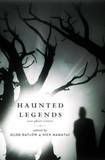 Tor Books / September 2010
Tor Books / September 2010
Reviewed by: Norman L. Rubenstein
Reading a book or story, to some extent, is a matter of trust. Readers might recognize an author’s name and remember that they’ve read previous books/stories by that author which they enjoyed, or which shocked them, in a good way, or which made them reflect on something. They will then choose to read the new story or book trusting that the same author will provide the same innate qualities in the new story or book which they’d enjoyed previously. The same kind of trust can also occur between a publisher and a reader in the genre-specific specialty presses, where a given publisher might have published a number of books which the reader had read and enjoyed, and, through time, the reader may well trust that a new title from this same publisher will likely provide similar entertainment value.
However, when it comes to anthologies, collections of short fiction by numerous differing authors, if there is any trust to be engendered, it is the editor(s) to whom the readers will turn to for such reassurance. Whether the anthology is themed (where all the stories have some common idea or point of reference that provides a general theme for the stories contained within the collection), or where there is no common theme, and the editor or editors have merely assembled a collection of quality tales they think that readers will enjoy reading, the readers must trust to the capability of the editor(s) to select a range of fiction that does not repeat itself and provides for entertainment and mental stimulation for the readers.
The new anthology edited by Ellen Datlow and Nick Mamatas, Haunted Legends, is a themed anthology. As co-editor Nick Mamatas states in his Introduction:
“Our concept was simple: ask some of the best writers of horror and dark fantasy in the world to choose their favorite “true” regional ghost story, and to rescue it from the cobwebs of the local tourist gift shop or academic journal.” (Haunted Legends, at p. 16)
If Nick Mamatas’ name seems familiar, it should be. He has written two novels and over fifty short stories in the horror and dark fantasy genre, all quite good, and is also a prolific reviewer and columnist who has written many informative articles and interviews and is considered, rightfully, an expert within the genre. Ellen Datlow, the other co-editor of Haunted Legends, is someone who is the very essence of the proverbial “person who needs no introduction”. But, just in case…Ms. Datlow is the preeminent living editor of horror, fantasy, and science fiction, having been doing so for almost thirty years and having won multiple awards for her editing work, such as the Bram Stoker Award, the World Fantasy Award, the Higo Award, the Locus Award, the Shirley Jackson Award, the International Horror Guild Award, and any other award you might be able to think of. Ms. Datlow is one of the very few editors, and certainly foremost among them, whose name is sufficient to trust that whatever anthology bearing her editorial name is placed before a reader, will be a worthwhile expenditure of time to read. As to how the combination of these two major talents have melded, I can only hope that they will continue their editing partnership based upon the results as contained within Haunted Legends. Their idea/theme for the anthology is both clever and of definite interest to those for whom good ghost stories become just that much better and more interesting, knowing they are based upon alleged “fact” or, at the least, actual existing local/regional historical traditions and folklore.
The anthology consists of twenty stories from the following authors: Richard Bowes, Kaaron Warren, Kit Reed, Steven Pirie, Caitlín R. Kiernan, Ekaterina Sedia, John Mantooth, Catherynne M. Valente, Carolyn Turgeon, Carrie Laben, Jeffrey Ford, Gary A. Braunbeck, Erzebet YellowBoy, M. K. Hobson, Stephen Dedman, Lily, Hoang, Laird Barron, Pat Cadigan, Ramsey Campbell, and Joe R. Lansdale. I’m certain that, like me, most of you will recognize at least some of these contributors and that others will be new to you. Again, if one is able to trust to the taste and judgment of the editor(s), then encountering new authors becomes an exciting prospect rather than a potentially worrisome gamble. So it is within the pages of Haunted Legends.
Obviously, to some extent, taste in reading material is subjective, and one person’s favorite story might well be another’s least favorite. That doesn’t necessarily make either person wrong or right. However, it is a measure of the quality of any anthology as to how many, if any, of the stories contained within are disliked by the reader. By such measure, Haunted Legends is a resounding success and deserves a solid “A” in that there was not a single story within the twenty collected that was less than good. Not a single story where the reader wondered “how did this story ever make it into the collection.” This is a feature that, in my personal experience, having read literally hundreds of collections in over forty-plus years of such reading, sets Ms. Datlow’s editing apart from virtually everyone else editing anthologies within the horror and dark fantasy genre. I cannot remember the last time any story contained in any of the numerous anthologies Ms. Datlow has edited ever struck me as being less than good. However, this isn’t to say that Haunted Legends does not contain a number of stories that I found exceptionally diverting and worthwhile reading.
The anthology starts off strongly with “Knickerbocker Holiday” by Richard Bowes. This is a very eerie, moody update, set in contemporary New York City relating to the “Headless Horseman” tales that inspired Washington Irving’s famous Sleepy Hollow tale. Another story very worthy of mention is Steven Pirie’s “The Spring Heel”. Set in contemporary England and involving a prostitute and her small band of itinerant friends, this updating of the classic “Spring Heel” legends, often related to Jack The Ripper, is a very enjoyable read. Then there’s “La Llorona” by Carolyn Turgeon. Here a woman whose child has died of cancer, travels on vacation to Mexico and there meets the legendary “Crying Woman” also well known throughout the American Southwest, who supposedly drowns her children to punish her lover in a fit of jealous rage and then repents and drowns herself as well, and whose ghost is said to wander the coastlines of lakes/rivers/bodies of water looking for her children. While some versions of her legend make La Llorona a sympathetic, helpful spirit, others describe her as very dangerous and vengeful, and who will steal the children of others. Here, the author writes an effective and moving new vision of the old legend well worth reading.
Another very entertaining read can be found in Jeffrey Ford’s “Down Atsion Road”. Dealing with the notorious New Jersey “Pine Barrens” area, here we have a winning combination of wilderness, Native Americans, and demons.
Leave it to the always brilliant Gary A. Braunbeck to take the well known legend/ghost story surrounding Resurrection Mary, and give it a unique, clever, and fascinating twist in his “Return To Mariabronn”. The quality continues with a brilliant story, “For Those In Peril On The Sea” by Australian author Stephen Dedman. The author takes a local infamous shipwreck and weaves a story involving a fictionalized version of the Fear Factor TV show, here called “Worst Nightmares” and delivers a supernatural romp guaranteed to shiver your timbers.
The anthology finishes even stronger than it begins, with three extremely inventive and thrilling stories among the final four by three of the finest authors writing in the horror/dark fantasy genre. First up is Laird Barron’s “The Redfield Girls”, which involves a haunted lake, which happens to be a popular tourist destination, located in the Washington State wilderness that was viewed as cursed way back among the ancient Klallam People. Then there’s Ramsey Campbell’s “Chucky Comes To Liverpool”. Here, the title tells you all you need to know: yes, it refers to that Chucky, the deadly toy which has been the subject of numerous movies, and which became intertwined with an infamous real-life child-murder in Liverpool in 1991. The anthology ends with a tour de force tale from American horror icon Joe R. Lansdale titled “The Folding Man”. The author takes as his starting point the tales of a mysterious black car or van that means trouble for those who encounter it, and spins a tale that will keep the reader on the edge of his seat.
My apologies to those authors whose included tales were not mentioned in this review. This does not mean that they are any less well crafted or are less enjoyable to read, but merely that a combination of space and the reviewer’s own personal predilections won out. What is important for potential readers to know is that Haunted Legends is a tremendously inventive and gratifying read. These stories are worthwhile for those with merely a general interest for tales of horror and dark fantasy. For those who especially enjoy ghost stories, this anthology will be supremely rewarding. Many of the stories here will stay in your head long after you’ve finished reading the book, and should give the interested reader much to ponder. Bravo to Ms. Datlow and Mr. Mamatas, and one hopes that this will be the beginning of a long-term professional, working partnership that will truly continue to benefit all horror/dark fantasy readers. All it takes is a little trust.
Purchase Haunted Legends edited by Ellen Datlow and Nick Mamatas.
Full Dark, No Stars / Stephen King
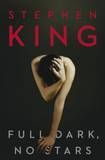 Scribner / November 2010
Scribner / November 2010
Reviewed by: Vince A. Liaguno
“When it came to the dark fuckery of the human heart,” one of King’s characters muses as she descends into near-madness in this quartet of novellas, “there seemed to be no limit.” And when it comes to exploring all that dark fuckery of the human heart, no one seems to possess the limitless capacity for such more than Stephen King. Full Dark, No Stars – the legendary dark scribe’s third collection in the four-novella format following 1982’s Different Seasons and 1990’s Four Past Midnight – explores the frightening lengths to which we’ll go to maintain normalcy and the status quo. Matters of the conscience factor in heavily here, with every action causing a stronger (and deeply consequential) opposite reaction among a cast of archetypal King characters – here ranging from an early 20th-century farmer to a modern-day midlist writer to everyday husbands and wives.
The collection opens with “1922”, a lush period piece about the desperate choices we make, our struggle to restore order, and the ghosts that subsequently haunt us. Told within the narrative structure of a confession, “1922” introduces us to Nebraska farmer Wilfred James who, as the story opens, is fearful that his free-thinking wife may sell one hundred acres of adjoining land to a hog butchery. When reasoning fails, desperation kicks in and he enlists the help of his teenage son to protect their land and livelihood. Murder and cover-up are quickly eclipsed by a big ‘ole dose of ghostly karma from the grave (or well, in this case). King’s ability to balance horror and humanity is on fine display here as graphic images of otherworldly rodents blend seamlessly with a father’s recognition of his very human failings with his son. You can almost hear Frank Darabont typing away at the screenplay now.
In “Big Driver”, King once again embraces an old-favorite – the writer as protagonist. This time out, readers meet Tess, successful author of a series of chick-light mysteries about a bunch of old women sleuths who solve crimes within the framework of their knitting circle. Following a book club speaking engagement, Tess unwisely takes a shortcut home and runs afoul of the titular character in one of King’s most relentless, brutal stories. But just when the reader starts to slip into the hopelessness of the main character’s violation and circumstances, King infuses “Big Driver” with healthy shots of feminism and adrenaline and takes Tess from victim to vigilante in a thoroughly satisfying mash-up of I Spit On Your Grave and Death Wish. Not for the squeamish.
“Fair Extension” – the shortest of the quartet – is a straightforward deal-with-the-devil tale in which a terminally ill man meets the devil himself, here cast as a roadside vendor who specializes in selling extensions of all shapes and sizes. Envy truly is a green-eyed monster here as Dave Streeter identifies his best friend as the one person he hates in exchange for a life extension. The ensuing reversals of fortune and misfortune in the two men’s lives are at once horrifying and heartbreaking in this morality tale that ably compensates in punch for what it lacks in word count.
Rounding out the collection, “A Good Marriage” is perhaps King’s strongest exploration of husband-wife dynamics since Dolores Claiborne or Gerald’s Game. When a dutiful wife stumbles (literally) upon proof of her seemingly virtuous husband’s dark side, conscience battles loyalty and security. As Darcy Anderson’s sense of right and wrong and that fine line between them blurs and shifts, the story studies with subtle brilliance the power of human resiliency and survival and justification. Like life, it’s compromise – and our ability to be able to look ourselves in the mirror – that ultimately wins in the end.
Throughout Full Dark, No Stars, readers are treated to the usual bounty of King literary riches – from his keen insights into commonplace life events (such as when anagrammed antagonist George Elvid in “Fair Extension” refers to chemotherapy as “knee-jerk triage” in the case of that story’s terminally ill protagonist), gorgeous personifications (such as when “graveyards yawn” in “A Good Marriage”), and sentences so evocative as to simultaneously lull and induce gooseflesh (like “On most nights, the dark was her friend – sleep’s kindly harbinger – but not tonight” from “A Good Marriage”).
But it’s in his Afterword – comprised mainly of an unusually trite recap of where each idea that led to the stories the reader has just taken in came from – that King offers an added gem in what is perhaps the strongest, most concise distinction between literary and genre fiction:
“I have no quarrel with literary fiction, which usually concerns itself with extraordinary people in ordinary situations, but as both a reader and a writer, I’m much more interested by ordinary people in extraordinary situations. I want to provoke an emotional, even visceral, reaction in my readers. Making them think as they read is not my deal. I put that in italics, because if the tale is good enough and the characters vivid enough, thinking will supplant emotion when the tale has been told and the book is set aside (sometimes with relief).”
True to his word, King will coax strong reactions from the tales he puts forth in Full Dark, No Stars, — fear, apprehension, outrage, melancholy, to name a few — and leave the reader scarce time to sort out the literary viscera he packs into every story. It’s in that glorious digestion process afterward that one realizes that the bogeymen that haunt King’s fictional worlds are no slouches when it comes to substantive matters of the heart, the conscience, and the darkest depths of the soul itself.
Purchase Full Dark, No Stars by Stephen King.
Curse of the Full Moon / Edited by James Lowder
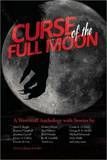 Ulysses Press / June 2010
Ulysses Press / June 2010
Reviewed by: Blu Gilliand
The werewolf is the middle child of the horror genre, stuck between its older, more accomplished sibling the vampire and the younger, brash upstart, the zombie. The werewolf has never had the classic showcase of a Dracula or the popular tidal wave of a Twilight series. Unlike zombies, it’s not enjoying a resurgence thanks to a popular cable series and books by Brian Keene. In fact, most of the success that’s come the werewolf’s way has been of the cinematic kind — think The Howling and The Wolf Man and An American Werewolf in London.
But I’ve always liked a good werewolf story. I see a lot of untapped potential in the character. The idea of transformation, of becoming something new and primal and powerful, is rich earth for authors to mine. So I was excited to crack open editor James Lowder’s Curse of the Full Moon, hoping that some of the high-pedigree writers featured would breathe new life into the character. They did just that, as many of the stories find success by playing around with the traditional rules and conventions of the werewolf character.
For example, the collection kicks off with “My Zoondel,” a Jonathan Carroll story that doesn’t include fangs and fur, but instead is a look at how the beasts within some people stay buried so deeply that their true nature isn’t revealed by physical transformation but instead by bursts of unexplained violence.
Charles de Lint’s “Trading Hearts at the Half Kaffe Café” introduces a slew of new approaches to the classic monster, referred to here as “skinwalkers.” In de Lint’s world of klans and codes of honor, the species is divided into those who wish to live a normal human life and those who “still like to hunt.” These opposing worldviews come to a tense head in de Lint’s tale.
Joe R. Landale can always be counted on to put a unique spin on whatever kind of story he’s writing, and he doesn’t disappoint with “The Gentleman’s Hotel.” The story, a highlight of the collection, melds the werewolf story with Lansdale’s signature take on the Wild West. “Hotel” teams up Lansdale’s Rev. Mercer character with May, a professional girl (ahem) with a colorful vocabulary, and Dol, a ghost who’s already fallen on the bad side of the evil invading the frontier town of Falling Rock. The story moves at a rapid pace and culminates in a blistering finale as werewolves lay siege on the hotel where our heroes are holed up. At one point there are two werewolves, two people, two guns and a horse fighting it out in one hotel room. Great stuff, and a brilliant example of what can be done with the werewolf when a writer really turns loose on the material.
“Lila the Werewolf” by Peter S. Beagle examines the difficulties inherent in dating someone who, every so often, simply loses control. Farrell is a guy whose capacity for acceptance has always suited him well, allowing him to get through situations that would have crumbled others. It’s a trait that comes in handy when he discovers that the new love in his life is, in fact, a werewolf. Unfortunately, even Lila’s full moon transformations can’t keep Farrell interested in the relationship for long, and he finds himself in the difficult position of wanting to break up. With a werewolf.
As with any collection, all is not perfect. The title of Matt Venne’s story – “The Brown Bomber and the Nazi Werewolves of the S.S.” – had me anticipating greatness from the moment I saw it in the table of contents, but unfortunately it’s one of the weak spots in Curse. Venne (who is currently attached to the television adaptation of Stephen King’s Bag of Bones) is going for a pulp feel with this story, but really only captures it in the title. The story sees boxer Joe Louis (The Brown Bomber himself) captured by Nazis and taken to a castle deep behind enemy lines, where he’s forced to fight a German-engineered werewolf in the boxing ring. Looking on from the stands is Louis foe Max Schmeling, who was hoping for a rematch with Louis after suffering an embarrassing defeat at his hands in America. Sounds great, right? Unfortunately, the attempts at humor fall flat, and the climactic fight is anticlimactic, abrupt and disappointingly executed. It’s a shame, because that title is fantastic.
Overall, though, Curse of the Full Moon is a success. Lowder has smartly chosen stories (the majority of which are reprints) that take the werewolf out of the moors and introduce it into a variety of settings and time periods. Silver and moonlight play an integral role in some stories, and are laughed away in others. It all makes for a great mix of moods and approaches that showcase the versatility inherent in one of the classic monsters of the horror genre.
Purchase Curse of the Full Moon edited by James Lowder:




